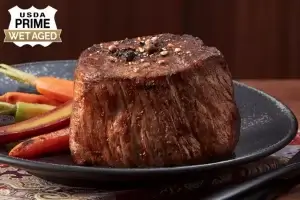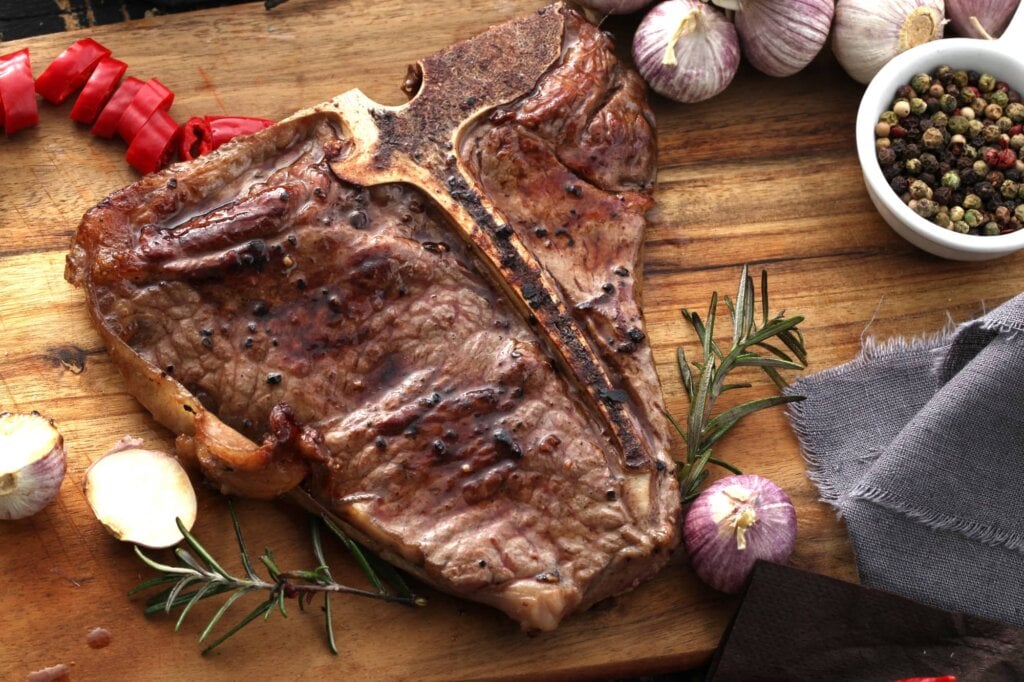
When it comes to a show-stopping steak dinner, the T-bone delivers in every bite. You get that classic, beefy flavor of a strip steak and the buttery tenderness of a filet, all in one cut. Broiling a T-bone is a straightforward way to develop a savory crust and maintain those juicy juices, turning ordinary dinners into memorable feasts. Learn how to do it with this expert guide and recipe.
Broiling vs. Grilling T-Bone Steak
Grilling and broiling are similar and have different purposes, but they work a little differently. When you grill, the heat comes from underneath whatever you’re cooking. With broiling, the heat is on top of what you cook. Grilling also creates smoke, yielding the smoky flavors that are easily recognizable with grilled foods (plus those eye-catching grill marks!). On the other hand, broiling is more like pan searing, where you’ll get an even golden-brown crust on the steak’s exterior without the smokiness.
So why might you use broiling over grilling? Grilling is usually an outdoor activity, so if it’s cold or rainy outside, it’s not always the most convenient method. It can also be messy to clean a grill and can take some time to prepare, especially if you’re using a charcoal grill. In contrast, broiling leaves little mess aside from the pan you use to cook on, and because the broiler is inside your oven, you can use it whenever you’d like, regardless of the weather.
T-Bone Selection and Preparation
The most important part of T-bone selection is probably the size of the cut. T-bone is supposed to be pretty large with a good-sized strip and tenderloin on either side. Most importantly, make sure the tenderloin section is relatively thick — 1.5 inches is a good rule of thumb.
Also, watch for marbling, or the white strips of fat that are scattered through the meat. You’ll want plenty of marbling, but try to avoid T-bones with chunks of fat dispersed through the meat or on the outside. These chunks won’t have enough time to render down with the quick cooking process of broiling.
As for color, cherry red is best. This indicates that your steak is fresh and high quality.
To prepare the T-bone for the broiler, rest it for 30 minutes at room temperature. Then, pat it completely dry with paper towels. Brush it with a thin layer of olive oil before seasoning it with salt and pepper on both sides. Place the steak on a wire rack atop a baking sheet, in a broiler pan, or in a preheated cast-iron skillet to cook.
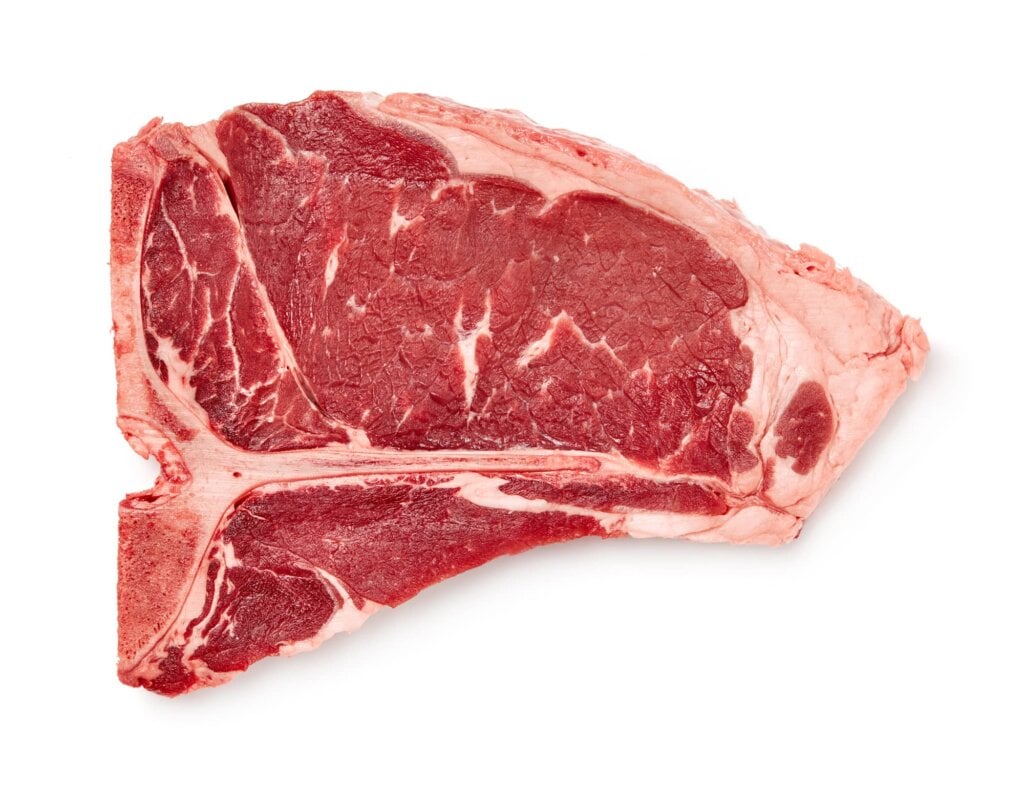
Tips & Tricks for the Best Broiled T-Bone Steak
There are a few things to remember as you broil T-bone steak to get the best results.
First, be sure to position your oven rack a few inches below the heating element so the steak sits close enough to crisp up without burning. About 3-4 inches away from the broiler is a good rule of thumb. Also, if you have a cast-iron pan to cook the steak on, you can use it instead of a broiler pan or baking pan with a wire rack. Just preheat the cast-iron pan before adding it to the broiler to help your T-bone cook evenly and get a crispy crust.
When cooking, remember that the T-bone is made of two cuts — the strip and tenderloin — which cook at different rates. You may need to rotate or flip the steak if one side browns too quickly, depending on how your broiler works. Keep an eye on the T-bone’s progress by checking it every couple of minutes.
How Long Do You Broil T-Bone Steak?
The length of time it takes to broil T-bone steak generally depends on how efficient your broiler is and how evenly it cooks, so this can vary quite a bit with different ovens. In most cases, you can expect a medium-rare T-bone to need 5-7 minutes of broiling time, assuming you preheated the broiler and let the steak rest at room temperature for at least 30 minutes before cooking.
The following chart breaks down time expectations for different doneness levels.
Broiling Steak Chart
Follow the chart below as a guide when broiling T-bone steak. Note that ovens can vary, so your times might differ slightly from those below.
| Doneness Level | Temperature to Remove Steak from Broiler | Final Temperature After Resting | Cooking Time |
| Rare | 120°F | 125°F | 4-6 minutes |
| Medium-rare | 125°F | 130-135°F | 5-7 minutes |
| Medium | 135°F | 140-145°F | 6-8 minutes |
| Medium-well | 145°F | 150-155°F | 7-9 minutes |
| Well done | 155° | 160°F | 8-10 minutes |
Broiled T-Bone Steak Recipe
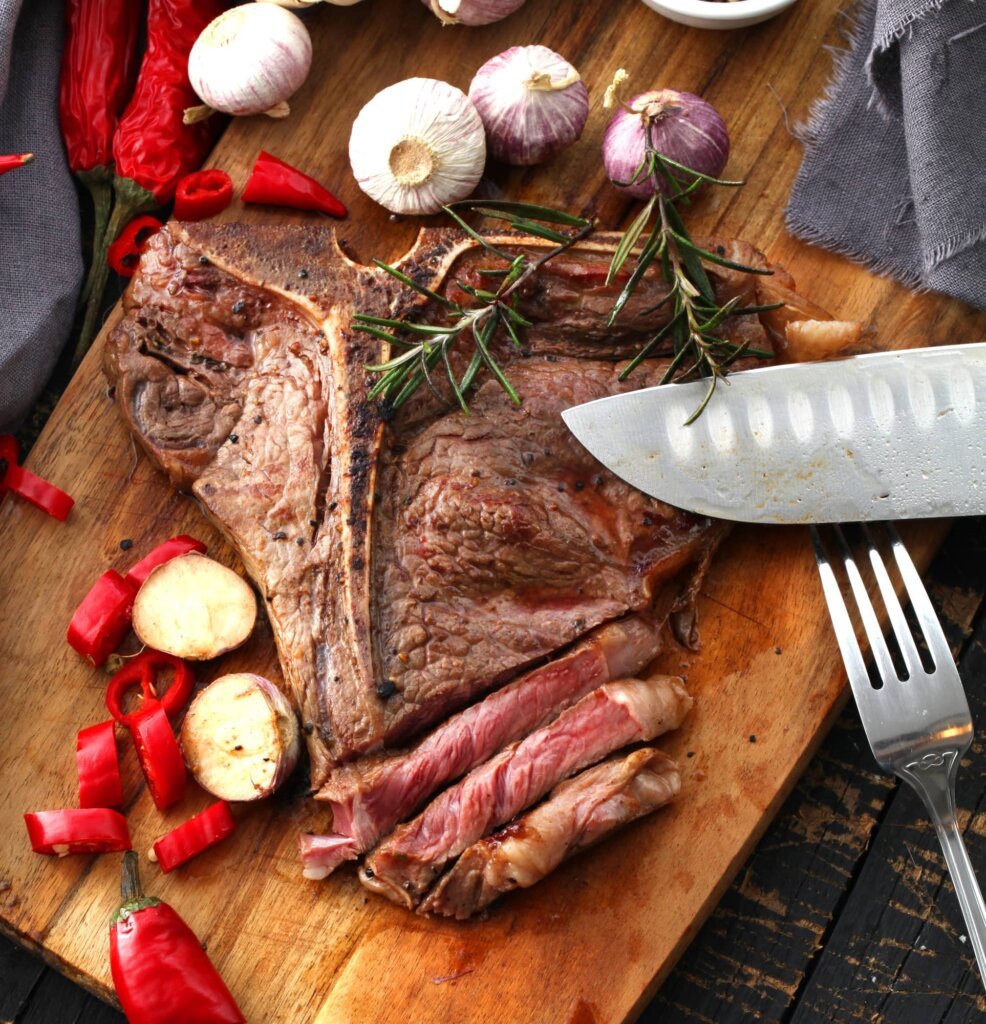
Ready to start cooking? Here’s what you need to do:
Ingredients
- 1-2 Premium Angus Beef T-Bone steaks
- Olive oil
- Salt
- Black pepper
Instructions
- Leave the steaks at room temperature for 30-45 minutes before cooking.
- Preheat the broiler for 10-15 minutes. Meanwhile, pat the steaks dry, add a light layer of olive oil to both sides, and season them generously with salt and pepper.
- Place steaks on a broiling pan, a baking pan with a wire rack, or a preheated cast-iron skillet. Transfer to a rack that’s 3-4 inches away from the broiler element.
- Cook for 3-4 minutes before flipping the steaks to the other side and rotating them a half a turn. Cook for another 2-3 minutes or until the tenderloin section reaches 125°F for medium rare. Refer to the chart above for cooking times for other doneness levels.
Conclusion: Broiling T-Bone Steak
Broiling a T-bone at home offers a quick path to that steakhouse-level steak right in your own kitchen. With a well-seasoned T-bone, careful timing, and a short resting period, you’ll broil your way to a deliciously flavorful and tender T-bone steak.
Get the best T-bone steak your money can buy when you order premium, aged T-bone from Chicago Steak Company.
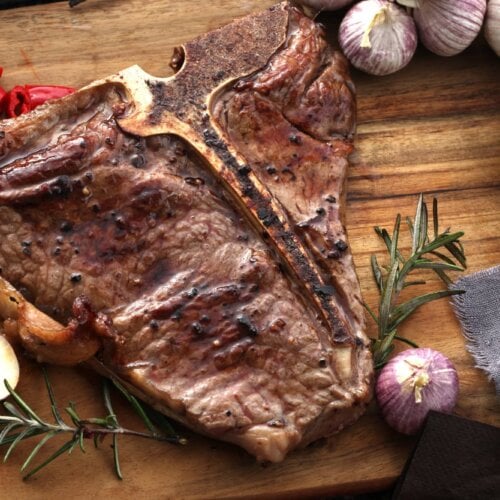
Broiled T-Bone Steak
Ingredients
- 1-2 Premium Angus Beef T-Bone steaks
- Olive oil
- Salt
- Black pepper
Instructions
- Leave the steaks at room temperature for 30-45 minutes before cooking.
- Preheat the broiler for 10-15 minutes. Meanwhile, pat the steaks dry, add a light layer of olive oil to both sides, and season them generously with salt and pepper.
- Place steaks on a broiling pan, a baking pan with a wire rack, or a preheated cast-iron skillet. Transfer to a rack that’s 3-4 inches away from the broiler element.
- Cook for 3-4 minutes before flipping the steaks to the other side and rotating them a half a turn. Cook for another 2-3 minutes or until the tenderloin section reaches 125°F for medium rare. Refer to the chart above for cooking times for other doneness levels.


